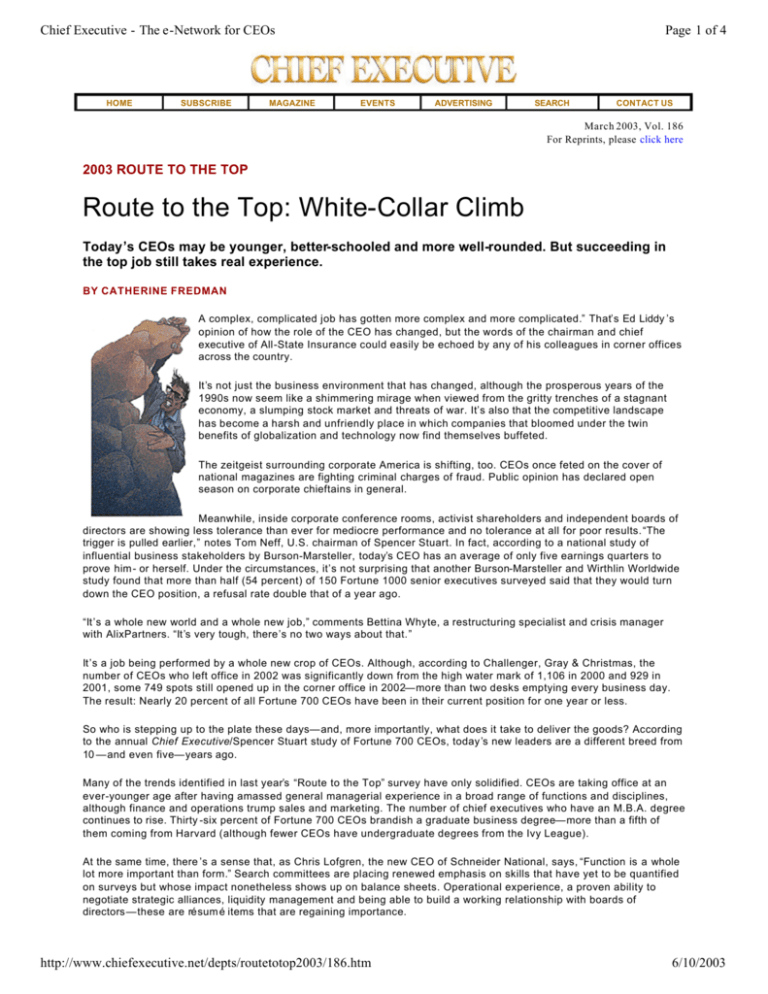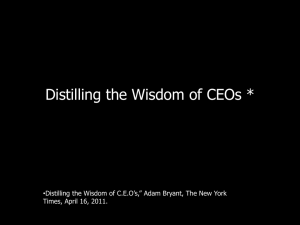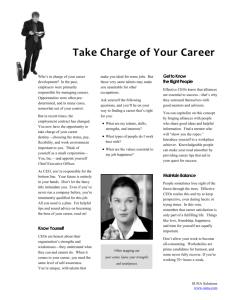
Chief Executive - The e-Network for CEOs
HOME
SUBSCRIBE
MAGAZINE
Page 1 of 4
EVENTS
ADVERTISING
SEARCH
CONTACT US
March 2003, Vol. 186
For Reprints, please click here
2003 ROUTE TO THE TOP
Route to the Top: White-Collar Climb
Today’s CEOs may be younger, better-schooled and more well-rounded. But succeeding in
the top job still takes real experience.
BY CATHERINE FREDMAN
A complex, complicated job has gotten more complex and more complicated.” That’s Ed Liddy ’s
opinion of how the role of the CEO has changed, but the words of the chairman and chief
executive of All-State Insurance could easily be echoed by any of his colleagues in corner offices
across the country.
It’s not just the business environment that has changed, although the prosperous years of the
1990s now seem like a shimmering mirage when viewed from the gritty trenches of a stagnant
economy, a slumping stock market and threats of war. It’s also that the competitive landscape
has become a harsh and unfriendly place in which companies that bloomed under the twin
benefits of globalization and technology now find themselves buffeted.
The zeitgeist surrounding corporate America is shifting, too. CEOs once feted on the cover of
national magazines are fighting criminal charges of fraud. Public opinion has declared open
season on corporate chieftains in general.
Meanwhile, inside corporate conference rooms, activist shareholders and independent boards of
directors are showing less tolerance than ever for mediocre performance and no tolerance at all for poor results. “The
trigger is pulled earlier,” notes Tom Neff, U.S. chairman of Spencer Stuart. In fact, according to a national study of
influential business stakeholders by Burson-Marsteller, today’s CEO has an average of only five earnings quarters to
prove him - or herself. Under the circumstances, it’s not surprising that another Burson-Marsteller and Wirthlin Worldwide
study found that more than half (54 percent) of 150 Fortune 1000 senior executives surveyed said that they would turn
down the CEO position, a refusal rate double that of a year ago.
“It’s a whole new world and a whole new job,” comments Bettina Whyte, a restructuring specialist and crisis manager
with AlixPartners. “It’s very tough, there’s no two ways about that.”
It’s a job being performed by a whole new crop of CEOs. Although, according to Challenger, Gray & Christmas, the
number of CEOs who left office in 2002 was significantly down from the high water mark of 1,106 in 2000 and 929 in
2001, some 749 spots still opened up in the corner office in 2002—more than two desks emptying every business day.
The result: Nearly 20 percent of all Fortune 700 CEOs have been in their current position for one year or less.
So who is stepping up to the plate these days—and, more importantly, what does it take to deliver the goods? According
to the annual Chief Executive/Spencer Stuart study of Fortune 700 CEOs, today ’s new leaders are a different breed from
10 —and even five—years ago.
Many of the trends identified in last year’s “Route to the Top” survey have only solidified. CEOs are taking office at an
ever-younger age after having amassed general managerial experience in a broad range of functions and disciplines,
although finance and operations trump sales and marketing. The number of chief executives who have an M.B.A. degree
continues to rise. Thirty -six percent of Fortune 700 CEOs brandish a graduate business degree—more than a fifth of
them coming from Harvard (although fewer CEOs have undergraduate degrees from the Ivy League).
At the same time, there ’s a sense that, as Chris Lofgren, the new CEO of Schneider National, says, “Function is a whole
lot more important than form.” Search committees are placing renewed emphasis on skills that have yet to be quantified
on surveys but whose impact nonetheless shows up on balance sheets. Operational experience, a proven ability to
negotiate strategic alliances, liquidity management and being able to build a working relationship with boards of
directors —these are résum é items that are regaining importance.
http://www.chiefexecutive.net/depts/routetotop2003/186.htm
6/10/2003
Chief Executive - The e-Network for CEOs
Page 2 of 4
In addition, today’s new breed of CEO shares character attributes that will never
show up on a r ésum é but are critically important to the future of a company. Such
intangible assets include the ability to listen and learn, impeccable ethics, even a
certain empathy. Grandstanding and celebrity are out; humility and credibility are in.
“My first 100 days are all about listening and learning,” remarked Paul Pressler in his
first interview after taking the top job at Gap in September. “The last thing you’ll get
from me is a grand vision in the first 100 days. You need to give yourself time to be a
sponge.”
After the glistening chimera of the dot-com bubble, the stomach-sinking accounting
scandals and the burgeoning bankruptcies, there ’s a return to fundamentals. Chief
among them is a redefinition of leadership. Forget flowery words or magic formulas
crafted by corporate communications wizards. “When you boil leadership down to its
common traits, it’s the ability to get people to work towards a common goal,” says
Peter Crist, president of Crist Associates, an executive search firm. The results of
this year’s survey provide an indication of the skills new leaders will need to achieve
those goals in an increasingly complex and demanding environment.
Age: Prime time comes earlier
The average age of CEOs has held steady at 56 for the past four years. But don’t let
that fool you. While more than half of all CEOs surveyed are between 50 and 59,
candidates are being tapped for the top job at ever-younger ages. Older chief
executives are rapidly becoming extinct. In 1980, more than half the CEOs of
Fortune 100 companies were in their 60s; today, it’s barely a quarter. Although
technology companies were —and continue to be —a proving ground for CEOs who
can read their email without donning bifocals, fortysomethings are having a chance
to lead across the board, from Honeywell’s David Cote and Schneider National’s
Lofgren to Louis Camilleri at Philip Morris, Bob Eckert at Mattel and August A. Busch
IV at Anheuser-Busch.
More and more CEOs believe that the increasingly rigorous demands on the time
and performance of a CEO require the stamina of a younger person. “You need a
very high energy level,” agrees Harry Jansen Kraemer Jr., who became CEO of
Baxter International four years ago at 44. “I know people in their 60s who have a high energy level but, honestly, not a lot
of them. ”
While Jansen Kraemer sees an advantage in having a CEO who is young enough to relate to the younger people in the
workforce, he doesn’t necessarily make age a major screen for top candidates. They still must have solid experience. “I
think it comes down to a maturity level, ” he says. “At what point in time are you really a leader?”
Good question. On the one hand, the flattening of hierarchy and streamlining of organizational layers during the 1990s
gave many of today’s recent picks a chance to run business units sooner in their careers than they might have
otherwise. But on the other hand, those same trends have compressed the number of potential candidates—and that’s a
problem.
Shorter—and shortened—CEO tenures are wreaking havoc with succession plans.
“Even in companies with good development plans, if the board of directors decides
they need a new CEO now rather than five years hence, there may not be
somebody ready internally,” notes Neff. Adds Spencer Stuart President Dayton
Ogden, “It’s harder and harder to hold onto your No. 2 because everybody like us is
looking to see if he or she is ready to be number one somewhere else.”
Company tenure: Redefining ‘long-term’
To stay or not to stay: that is the question all aspiring CEOs must wrestle with. In
1980, the average Fortune 100 CEO spent 26 years with one company. Today, the
median tenure of Fortune 100 CEOs is 19 years; for the rest of their Fortune 700
counterparts, it’s barely 16 years—just enough time to join a company after getting
an MBA and make the inner circle by one’s early 40s. And while the percentage of
Fortune 700 CEOs who have stayed at the same company for their entire career
continues to hold steady at 25 percent—count among them Mike Eskew at UPS,
Jansen Kraemer at Baxter, Lofgren, and, of course, Jeffrey Immelt, who beat out
fellow longtime colleagues Robert Nardelli and James McNerney to get the top job
at General Electric—barely one-third of their Fortune 100 colleagues stick around
for the long haul.
“Longevity is part of our success at UPS,” says Eskew. “On the executive floor, the
average tenure is 30 years.” But this is an exception to what has become a trend:
ambitious managers leaving their companies for jobs where they can get general
http://www.chiefexecutive.net/depts/routetotop2003/186.htm
6/10/2003
Chief Executive - The e-Network for CEOs
Page 3 of 4
management experience.
When Neff is shopping around, he relies on old favorites like Colgate, Emerson, GE, United Technologies and Johnson
& Johnson, well-run and highly diversified companies that by definition have plenty of openings for general managers
and routinely produce experienced executives with a global outlook. Retail companies are another tried-and-true source,
because each department store chain names its own CEO.
Similarly, PepsiCo has three CEO jobs within its restaurant group alone. Neff believes that IBM is getting better at
incubating top talent; American Airlines also gets his nod for developing a cadre of strong, financially trained general
managers. But for the most part, says Ogden, “Companies do a great job developing financial or marketing executives
but they don’t do a good job developing great general managers.” Adds Neff, “Frankly, it’s kind of hard to name a lot of
companies that get it.”
CEO tenure: Hello, I must be going
It’s getting to the point where even some baseball managers are staying with the
same team longer than many CEOs. The average tenure in a Fortune 100 corner
office is six years. However, knock out scale-skewers like longtime leaders Reuben
Mark of Colgate -Palmolive, Michael Dell and AIG’s Hank Greenberg —still hanging
tough and delivering profits at age 77 —and the median tenure drops to just four
years.
The good news: Fewer CEOs in this year’s survey have been in their current position
for one year or less, suggesting the house-cleaning in the wake of corporate
scandals and abysmal performance may have thrown out the last of the junk. CEO
turnover will continue to slow, predicts New York-based compensation specialist
Pearl Meyer, because the continued lackluster economy will mask below-average
performance.
Even given the turmoil of the recent past, however, the majority of CEOs just aren’t
sticking around for the long haul. The reasons remain the same as last year, only
more so. Increased governmental scrutiny devours time from a demanding day
already crammed with the normal pressures of dealing with shareholders, visiting
customers and maintaining an often brutal travel schedule that results in a lot of lost
weekends and family time. Meanwhile, the pace of change continues to accelerate,
testing the ability of CEOs to adapt to different—and often difficult—circumstances.
Many may not be able to adapt. The recent classes of CEOs are matriculating during
the third consecutive year of economic malaise. Thanks to the long bull market of the
1990s, few have had the experience of being a general manager during an
economic downturn, let alone the head of a company. Meanwhile, shareholders and
boards of directors are impatient for results and less tolerant of missteps. “This was
a tough job a year ago and is an even tougher job now,” says Ogden, president of
Spencer Stuart.
Career history: Balance is best— but can they read a balance
sheet?
The number of Fortune 700 CEOs who have followed one functional path throughout
their entire career continues to decrease; among chief executives in Fortune 100
and 200 companies, only 12 percent had no experience outside of one function. In
part, that figure is the result of changes in corporate structure that have replaced
silos with cross-functional divisions. But it also reflects a demand for general managers who possess a range of
disciplines and skills.
“When I ’ve seen successful CEOs, they’re pretty balanced,” says Jim Bonsall, a turnaround specialist for AlixPartners.
“They understand the operating side, the legal side, sales and customers. It’s when they get over-focused on one side or
another that they ’re going to get into trouble.”
Antipathy towards the notion of the celebrity CEO has also enhanced the attraction of someone who understands the
nuts and bolts of business. “Historically, if you were doing a CEO search, the marquee attributes and personality of the
candidates overshadowed their operating skills,” notes Peter Crist. Now, he adds, that’s no longer the case.
Statistics bear out this shift. Once
again, the top two most common
functions among Fortune 700 CEOs
are finance and operations, with
marketing and sales a distant third and
fourth.
http://www.chiefexecutive.net/depts/routetotop2003/186.htm
6/10/2003
Chief Executive - The e-Network for CEOs
Page 4 of 4
“The benefits of being a CFO is that it requires you to connect the dots in all areas of the company, see how Part A
relates to Part B and see how it all comes together on a financial statement,” says All -State CEO Liddy, who was chief
financial officer at Sears before moving to his current position. “To the extent you understand the dynamics of a financial
report card, maybe you’re a little better. And with all that’s going on with Sarbanes-Oxley and the demand for
transparency in financial statements, it may be easier if you have formal financial training.”
The more experience, the better
With the exception of dealing with Sarbanes-Oxley, Chris Lofgren of Schneider National makes the same argument for
having a strong background in technology. Lofgren, who recently succeeded the legendary Don Schneider, is proof that
CIO doesn ’t have to stand for “Career Is Over. ” “From my perspective, the technology background gave me the
opportunity to look across every aspect of the business,” he says. “That’s a tremendous opportunity to understand a
company.”
With globalization as one of the largest forces shaping-the competitive landscape, one would expect international
experience to be a plus. It is, in fact, on the rise with 34 percent of this year’s Fortune 100 CEOs having worked abroad,
up from 31 percent five years ago. However, while there ’s much to be said for the autonomy, as well as the experience,
of working overseas, the old notion of “out of sight, out of mind” still haunts some ambitious candidates, even given
today ’s technology.
What’s more, fewer foreign assignments may be available in the future to Americans. “I think more companies are trying
to use foreign nationals in their business—they know the local culture and mores of the people,” muses Larry Bossidy,
former CEO of Honeywell and AlliedSignal. “Companies had trouble doing that a decade ago because there simply
weren ’t enough foreign nationals who were well-trained.”
One thing is for sure: The increasingly complex nature of the top job cannot be trained for by a limited number of
assignments. “I would argue that the more different experiences you have, the better,” says Baxter CEO Jansen
Kraemer, who was CFO for five years at the company before jumping to the top slot. “A lot of people worry about the
specific skill sets that go into their bag. I don’t care what skill set you get, but if one way or another over a 10- or 12-year
period, you develop the ability to lead, have genuine self-confidence, realize you’re no better than anyone else, can
motivate people and help them realize what their true potential is, you’re going to go to the moon.”
The Chief Executive Group, L.P.
110 Summit Avenue, Montvale, NJ 07645
Phone:201-930-5959 All rights reserved.
http://www.chiefexecutive.net/depts/routetotop2003/186.htm
www.chiefexecutive.net
Site designed and hosted by Butler International
6/10/2003








